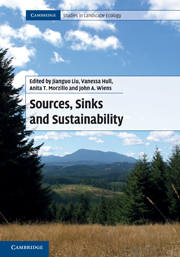Book contents
- Frontmatter
- Contents
- Contributors
- Preface
- Acknowledgments
- Part I Introduction
- Part II Advances in source–sink theory
- Part III Progress in source–sink methodology
- 9 On estimating demographic and dispersal parameters for niche and source–sink models
- 10 Source–sink status of small and large wetland fragments and growth rate of a population network
- 11 Demographic and dispersal data from anthropogenic grasslands: what should we measure?
- 12 Network analysis: a tool for studying the connectivity of source–sink systems
- 13 Sources, sinks, and model accuracy
- 14 Scale-dependence of habitat sources and sinks
- 15 Effects of experimental population removal for the spatial population ecology of the alpine butterfly, Parnassius smintheus
- Part IV Improvement of source–sink management
- Part V Synthesis
- Index
- References
10 - Source–sink status of small and large wetland fragments and growth rate of a population network
Published online by Cambridge University Press: 05 July 2011
- Frontmatter
- Contents
- Contributors
- Preface
- Acknowledgments
- Part I Introduction
- Part II Advances in source–sink theory
- Part III Progress in source–sink methodology
- 9 On estimating demographic and dispersal parameters for niche and source–sink models
- 10 Source–sink status of small and large wetland fragments and growth rate of a population network
- 11 Demographic and dispersal data from anthropogenic grasslands: what should we measure?
- 12 Network analysis: a tool for studying the connectivity of source–sink systems
- 13 Sources, sinks, and model accuracy
- 14 Scale-dependence of habitat sources and sinks
- 15 Effects of experimental population removal for the spatial population ecology of the alpine butterfly, Parnassius smintheus
- Part IV Improvement of source–sink management
- Part V Synthesis
- Index
- References
Summary
Many organisms persist in populations that are spatially structured by human-induced loss and fragmentation of their native habitats. Despite this, the demographic contributions of local populations to a population network and to the growth rate of such a network are still largely unexplored. Using data on individually marked young and adult female reed buntings (Emberiza schoeniclus) from 21 local populations studied over six years in northeastern Switzerland, we examined the source–sink status of small and large local populations with recently developed metrics. We hypothesized that including emigration to the population network (the Cr metric) would classify more local populations as sources than when only focusing on the ability of local populations to maintain themselves (the Rr metric). We further tested the hypothesis that the relative contribution of small and large local populations to the population network does not differ. The inclusion of emigration to the population network resulted in significantly higher values than when only considering the contribution of local populations to themselves, the difference between the metrics averaging 30%. Despite this, most local populations in our study turned out to be sinks (Cr value <1), suggesting that substantial immigration is required for maintaining local populations as well as the entire population network (growth rate of network always <1). Both large and small populations contributed equally to the population network. We conclude that (a) the source–sink status of local populations is more comprehensively described by metrics including emigration (such as Cr) than by metrics focusing on processes within local populations (such as Rr); (b) the network of local populations studied here is not viable without immigration; and (c) small local populations can be as valuable as large local populations in their contribution to a population network.
- Type
- Chapter
- Information
- Sources, Sinks and Sustainability , pp. 216 - 238Publisher: Cambridge University PressPrint publication year: 2011
References
- 7
- Cited by

